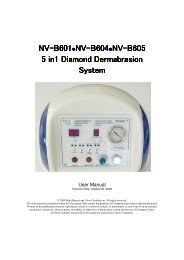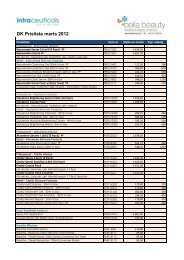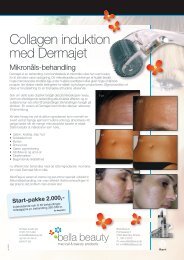Use of Intense Pulsed Light (IPL) in Indian Skin Types - ResearchGate
Use of Intense Pulsed Light (IPL) in Indian Skin Types - ResearchGate
Use of Intense Pulsed Light (IPL) in Indian Skin Types - ResearchGate
- No tags were found...
Create successful ePaper yourself
Turn your PDF publications into a flip-book with our unique Google optimized e-Paper software.
Results & DiscussionThe groups comprised hair removal: n=53; acne: n=35 and pigmentation: n=59. The overall average fluence used was11.6, 10.5 and 12.3 J/cm 2 respectively.The study was conducted <strong>in</strong> Chennai city <strong>in</strong> Southern India where the normal range <strong>of</strong> sk<strong>in</strong> types <strong>of</strong> patients seek<strong>in</strong>g treatmentis Fitzpatrick IV-V and the sunny climate is constantly hot and humid with an average ambient temperature even <strong>in</strong> airconditionedrooms above 25ºC. These climatic conditions <strong>in</strong>crease treatment-related problems and <strong>in</strong>crease the <strong>in</strong>cidence <strong>of</strong>post-treatment side effects aggravated by sun exposure to sk<strong>in</strong> areas exposed to <strong>in</strong>tense pulsed light or laser wavelengths.It is reasonable to assume that certa<strong>in</strong> pigmented lesions may be diagnosed accurately by an expert dermatologist asbenign without the benefit <strong>of</strong> histological validation (impossible where the treatment with light therapy is entirely non-<strong>in</strong>vasiveand no tissue is removed dur<strong>in</strong>g the procedure).The generally poor response after only one or two treatments confirms the importance <strong>of</strong> complet<strong>in</strong>g a course <strong>of</strong> <strong>IPL</strong>treatments at regular <strong>in</strong>tervals. Patients who failed to attend sufficient treatment sessions, showed reduced effectiveness asassessed by the expert cl<strong>in</strong>ician. Where more treatment sessions were given, <strong>in</strong> most cases better results were observed.In common with other anecdotally reported experience with laser and <strong>IPL</strong> devices <strong>in</strong> India, a conservative approach isnormally taken to choos<strong>in</strong>g treatment parameters and it is generally found that numbers <strong>of</strong> treatments needed to achievesatisfactory results are greater than <strong>in</strong> countries with lighter sk<strong>in</strong> types and even where treatment energy levels are similar,more treatments appear to be necessary.EfficacyTreatment outcomes were only assessed and recorded atthe end <strong>of</strong> a treatment or course <strong>of</strong> treatments when thepatient and/or dermatologist were satisfied that no furtherimprovement could be achieved, where the patient did notwish to cont<strong>in</strong>ue or where the patient simply failed to appearfor further scheduled treatments. The standard descriptions<strong>of</strong> efficacy used <strong>in</strong> this study by the expert cl<strong>in</strong>ical assessorwere graded and assessed as follows:Hair Reduction:Grade 0 = No reduction (25%),Grade 2 = Moderate Reduction (>50%),Grade 3 = Good Reduction (>70%).As expected, where multiple treatments were given thegreatest degree <strong>of</strong> hair reduction was achieved. In general,there was little reduction <strong>in</strong> regrowth <strong>of</strong> hair follicles after as<strong>in</strong>gle treatment, a moderate reduction only after 3-4treatments and <strong>in</strong> two cases <strong>of</strong> thick, facial hair, a goodreduction after 7 treatments. Table 2 <strong>in</strong>dicates better results <strong>in</strong>fewer treatments for cosmetic hair removal versus hirsutism.Intervals between treatments needed to be 3-4 weeks and thetrial subjects did not always follow this.There were fewer cases <strong>of</strong> cosmetic hair removal on bodyareas than might be seen <strong>in</strong> comparable studies <strong>in</strong> lighter sk<strong>in</strong>types. This is probably expla<strong>in</strong>ed by cultural preferences andtraditional <strong>Indian</strong> garment design.Figure 3—Hirsutism: Female, age 20 yrs, sk<strong>in</strong> type V, 50% reduction withregrowth <strong>of</strong> f<strong>in</strong>er lighter hair. 6 treatments at irregular <strong>in</strong>tervals over 10 monthsus<strong>in</strong>g a fluence <strong>of</strong> 11-13 J/cm2, triple sub-pulses: 14 ms on, 7 ms <strong>of</strong>f.Satisfaction3Significantreduction2Moderatereduction1Somereduction0No reductionCosmeticHisuitism1 2 3 4 5 6 7No. <strong>of</strong> treatmentsFigure 4—Hair Removal: Graph show<strong>in</strong>g patient satisfaction,with progressively better results with <strong>in</strong>creas<strong>in</strong>g numbers <strong>of</strong> treatments<strong>in</strong> both hirsutism and purely cosmetic hair removal cases5








